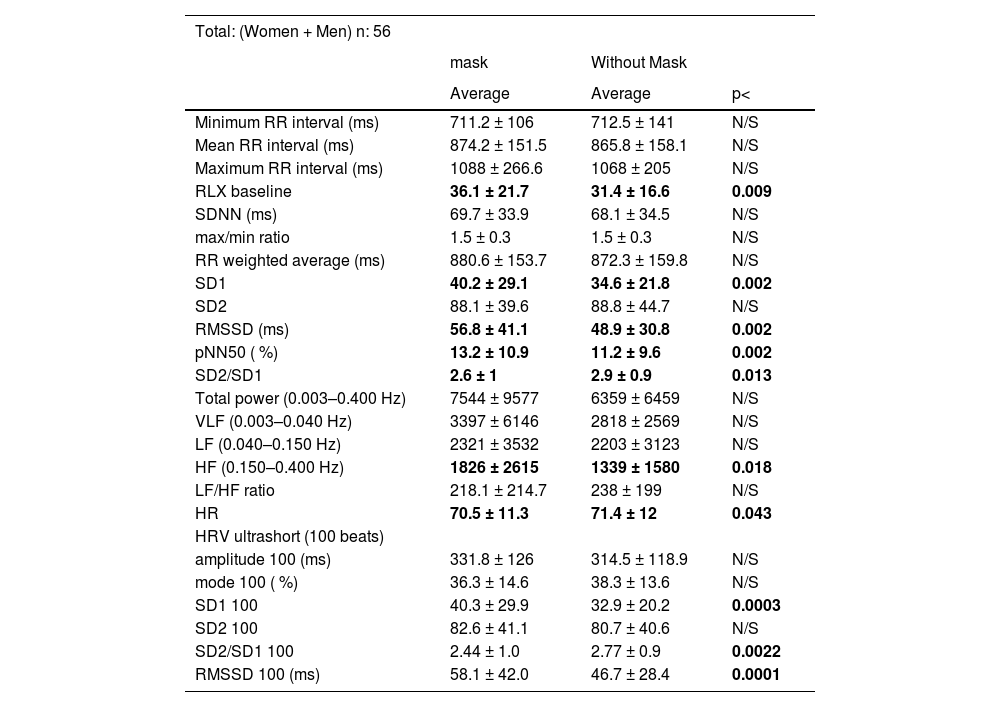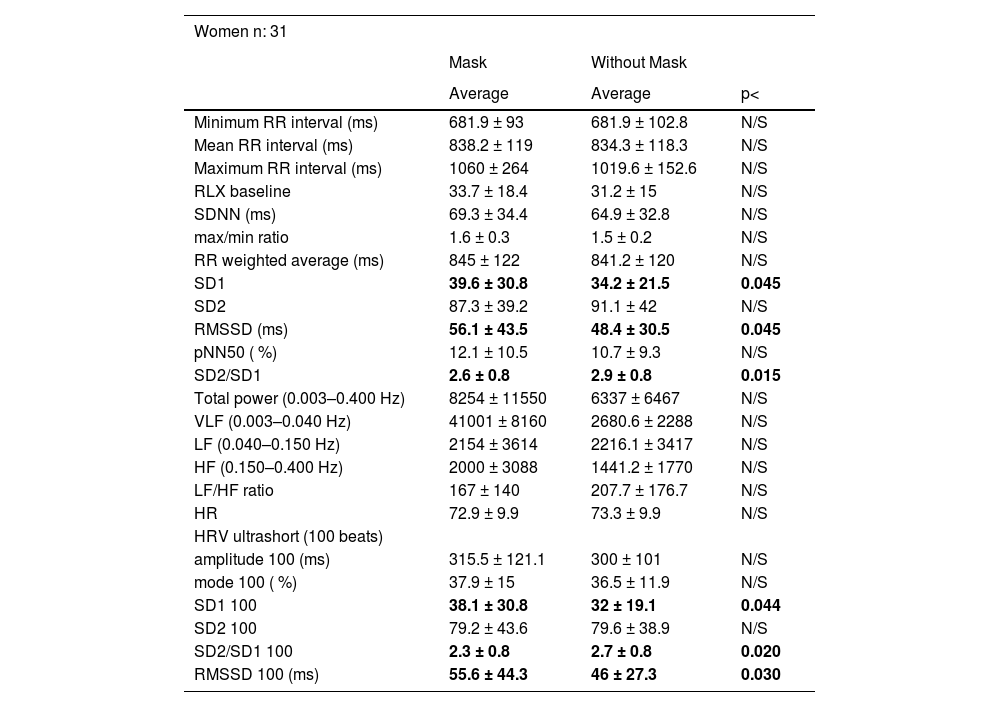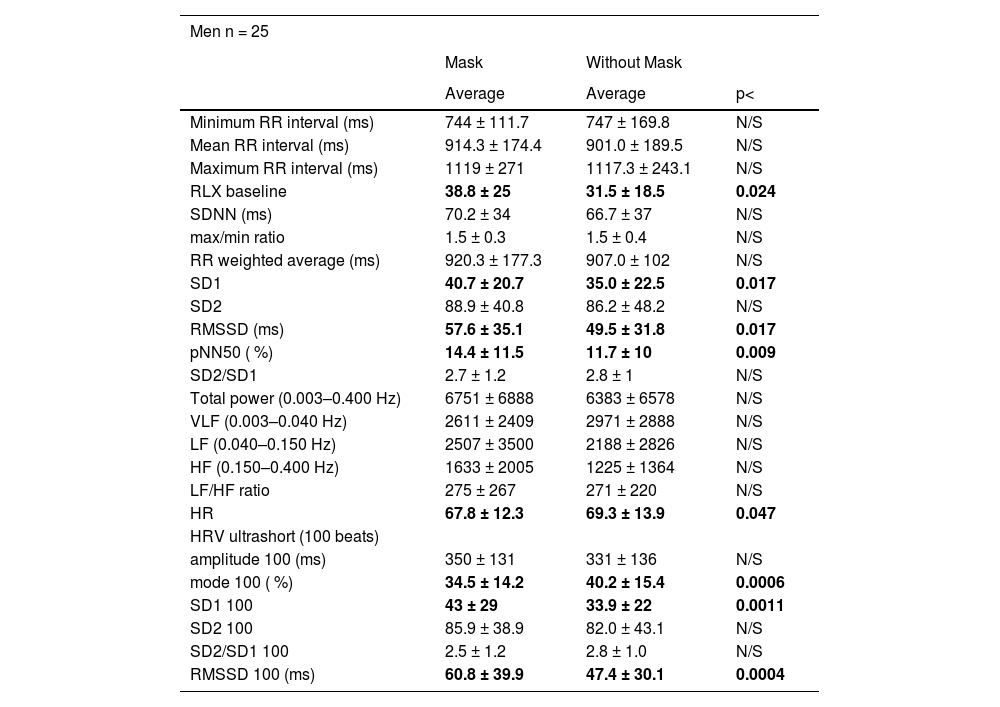During the imperative mandate of mask-wearing during the COVID-19 pandemic, our study aimed to elucidate the physiological repercussions stemming from hypoxia and hypercapnia induced by facemasks during periods of rest. Specifically, we investigated the influence of facemasks on heart rate variability (HRV) within a cohort of young athletes.
Material and methodsExperimental study in which 56 competitive adolescent athletes (55 % female) were evaluated. The heart rate data was recorded during 8-min, in meditative rest while seated. We conducted a comprehensive analysis of heart rate variability, examining both a 4-min segment and a 100-beat window. Comparisons were made between data recorded when subjects wore facemasks and when they breathed freely without masks. Data analysis was performed utilizing the Polar ProTrainer 5 software.
ResultsThe results showed relevant statistical differences at the level of cardiac variability (HRV): a) Heart Rate (mask: 70.5 ± 11.3 bpm vs no mask: 71.4 ± 12 bpm; p < 0.043. b) RMSSD (Mask: 56.8 ± 41.1 ms vs no mask: 48.9 ± 30.8 ms p < 0.002). c) RMSSD only 100 beats (mask: 58.1 ± 42.0 ms vs no mask: 46.7 ± 28.4 ms; p < 0.0001).
ConclusionsUpon removing the facemask while maintaining meditative rest, 86 % of the subjects exhibited a distinct sympathetic response during the subsequent 5-min period. Notably, in 13 % of participants, this sympathetic response persisted across both phases of the study. Furthermore, the analysis of Ultra-Short-Term Cardiac Variability based on 100 beats accentuated the significance of the observed differences.
The aim of this study is to replicate the findings published, regarding the modifications in Cardiac Variability induced by the use of facemasks for COVID-19 prevention, as detected through routine electrocardiograms, during the annual sports medicine screening.1 This work significantly increases the subject pool and incorporates a resting scenario to enable the investigation of Cardiac Variability under both masked and unmasked conditions. These findings add to the studies of the impact of hypercapnic hypoxia and rarefied air in various situations carried out, since 2008.2–6
Material and methodWe assessed 56 adolescent athletes (55 % female) including 9 who had recovered from COVID-19 and were in good athletic shape, as can be seen in Table 1. We measured their heartbeats in milliseconds using a Polar S800i heart rate monitor during an 8-min session of relaxation with soothing music while sitting.7 Participants wore Type IIR facemasks (model NM12458) adjusted with a post-cervical tensioner. We conducted a double analysis of heart variability (HRV) for 4 min and 100 beats, comparing results with and without masks. Data were analyzed using Polar ProTrainer5 software, prioritizing robust scientific knowledge on cardiac variability.8–10
Statistical studyContinuous variables were presented as means and standard deviations. A paired two-tailed T-test was employed to assess the significance of differences observed. When comparing the "men" and "women" groups, the variance of each group was determined due to the unpaired nature of the data, ensuring appropriate adjustment of the T-test.
The primary variables under scrutiny encompassed heart rate (HR) and the square root of the mean of the squares of the successive differences between adjacent normal beats (RMSSD).10
ResultsIn relation to cardiac variability (HRV), an analysis of 4 min of cardiac recording unveiled significant findings. Key parameters are as follows:
- 1.
Heart rate exhibited a statistically significant increase upon subjects' removal of face masks: Heart Rate (mask: 70.5 ± 11.3 bpm vs no mask: 71.4 ± 12 bpm).
- 2.
The square root of the mean of the squares of the successive differences between adjacent normal beats witnessed a highly significant decrease upon releasing subjects from face masks: RMSSD (Mask: 56.8 ± 41.1 ms vs no mask: 48.9 ± 30.8 ms).
Additional HRV parameters derived from the 4-min analysis are outlined below, as can be seen in Table 2, Table 3 and Table 4:
a) The Relaxation index analyzed using Polar (RLX), expressed in milliseconds, showcased a notable decrease upon subjects' mask removal (Mask: 36.1 ± 21.7 ms vs no mask: 31.4 ± 16.6 ms).
b) The width of the ellipse in the Poincaré diagram (SD1) exhibited a significant decrease when subjects were unmasked (Mask: 40.2 ± 29.1 ms vs no mask: 34.6 ± 21.8 ms).
c) The percentage of normal, successive heartbeats with a difference greater than 50 milliseconds (pNN50) demonstrated a significant decrease upon mask removal (Mask: 13.2 ± 10.9 % vs no mask: 11.2 ± 9.6 %).
d) Analysis in the frequency domain revealed a significant decrease in the high-frequency band (HF) upon subjects' mask removal (Mask: 1826 ± 2615 Hz vs no mask: 1339 ± 1580 Hz).
Heart rate variability results. Total number of subjects studied, men and women.
RLX baseline: Relaxation rate analyzed using PolarR (RLX), expressed in milliseconds. SDNN (ms): standard deviation of "n" normal intervals. SD1: The width of the ellipse in the Poincaré diagram, relative to successive "rr". SD2: Length of the ellipse in the Poincaré diagram. RMSSD (ms): The square root of the mean of the squares of the successive differences between adjacent normal beats. pNN50 ( %): the proportion of normal and successive rr intervals, greate than 50 milliseconds, divided by total number of intervals. Total power (0.003–0.400 Hz): VLF (0.003–0.040 Hz): the very low frequency (VLF) from 0.0033 to 0.04 Hz. LF (0.040–0.150 Hz): HF (0.150–0.400 Hz): high frequency from 0.15 to 0.4 Hz. HR: heartbeat frequency. HRV ultrashort (100 beats): Cardiac variability performed with 100 successive beats. Amplitude 100 (ms): Amplitude of the normal curve made with 100 successive beats. Mode 100 ( %): Statistical mode of the normal curve made with 100 successive beats, expressed in percentage.
Heart rate variability results. Women only.
RLX baseline: Relaxation rate analyzed using PolarR (RLX), expressed in milliseconds. SDNN (ms): standard deviation of "n" normal intervals. SD1: The width of the ellipse in the Poincaré diagram, relative to successive "rr". SD2: Length of the ellipse in the Poincaré diagram. RMSSD (ms): The square root of the mean of the squares of the successive differences between adjacent normal beats. pNN50 ( %): the proportion of normal and successive rr intervals, greate than 50 milliseconds, divided by total number of intervals. Total power (0.003–0.400 Hz): VLF (0.003–0.040 Hz): the very low frequency (VLF) from 0.0033 to 0.04 Hz. LF (0.040–0.150 Hz): HF (0.150–0.400 Hz): high frequency from 0.15 to 0.4 Hz. HR: heartbeat frequency. HRV ultrashort (100 beats): Cardiac variability performed with 100 successive beats. Amplitude 100 (ms): Amplitude of the normal curve made with 100 successive beats. Mode 100 ( %): Statistical mode of the normal curve made with 100 successive beats, expressed in percentage.
Heart rate variability results. Men only.
RLX baseline: Relaxation rate analyzed using PolarR (RLX), expressed in milliseconds. SDNN (ms): standard deviation of "n" normal intervals. SD1: The width of the ellipse in the Poincaré diagram, relative to successive "rr". SD2: Length of the ellipse in the Poincaré diagram. RMSSD (ms): The square root of the mean of the squares of the successive differences between adjacent normal beats. pNN50 ( %): the proportion of normal and successive rr intervals, greate than 50 milliseconds, divided by total number of intervals. Total power (0.003–0.400 Hz): VLF (0.003–0.040 Hz): the very low frequency (VLF) from 0.0033 to 0.04 Hz. LF (0.040–0.150 Hz): HF (0.150–0.400 Hz): high frequency from 0.15 to 0.4 Hz. HR: heartbeat frequency. HRV ultrashort (100 beats): Cardiac variability performed with 100 successive beats. Amplitude 100 (ms): Amplitude of the normal curve made with 100 successive beats. Mode 100 ( %): Statistical mode of the normal curve made with 100 successive beats, expressed in percentage.
Upon conducting data analysis solely with 100 beats, both with and without masks, the results exhibited even greater statistical significance:
a) SD1 only 100 beats (mask: 40.3 ± 29.9 ms vs no mask: 32.9 ± 20.2 ms; p < 0.0003).
b) SD2/SD1 only 100 beats (mask: 2.44 ± 1.0 ratio vs no mask: 2.77 ± 0.9 ratio; p < 0.0022).
c) RMSSD only 100 beats (mask: 58.1 ± 42.0 ms vs no mask: 46.7 ± 28.4 ms; p < 0.0001).
In our previous investigation,1 we elucidated the effect of mask usage on the neurovegetative equilibrium of the participants, resulting in an increased predominance of the parasympathetic component.
That initial study was conducted utilizing standard 10-s electrocardiograms (ECG) obtained while the subjects wore mandatory masks during the pandemic and was retrospectively compared with ECG data collected in the previous year.
The current study aimed to validate the results of the prior investigation by expanding the sampling duration of heart rate data to 4 min, both with the subject wearing a mask and breathing freely without a mask while at rest.
Likewise, the statistical analysis was replicated using series of 100 heartbeats to assess the efficacy of this "ultrashort" method, as well as various sphygmometry techniques (histogram of heart rate distribution with a 50 ms range) advocated by S. Tíjvinski15 in 1991. Additionally, the correlational rhythmogram (also known as Scaterogram, Poincaré diagram...) proposed by E. Zemtsovski et al. in 1977 was employed.16
Our findings elucidate the degree to which cardiac variability predominantly emerges as an adaptive reaction to subtle hypoxic and hypercapnic circumstances induced by the utilization of infection prevention masks. This adaptation demonstrates statistical significance across all pivotal variables scrutinized in our study, notably heart rate (HR) and the analysis of the interval between successive beats (RMSSD). Our results are consistent with the ultrashort methodologies advocated by Nunan et al.11
Contributions of our research reaffirm the conclusions drawn by our team regarding the impact of masks on neurovegetative balance.1 Furthermore moreover, it validates the efficacy and sensitivity of ultrashort methodologies in assessing heart rate variability (HRV),11–13 particularly the traditional 100-beat method.
Limitations of our study: In our investigation, the cohort consisting of "n = 31″ women had lower values for the primary parameters investigated: heart rate and RMSSD, in comparison to their male counterparts. However, it is noteworthy that the female participants were from a younger age group relative to the male cohort.
We attribute the observed discrepancy in adaptation to anatomical distinctions between the male and female subjects, rather than age-related effects. Specifically, it is acknowledged that individuals with greater stature typically possess a larger anatomical dead space. Consequently, in taller individuals, the dead space of the mask represents a relatively smaller proportion relative to their height.6
Our study focuses on short-term assessments conducted over durations of 5 min and 100 heartbeats. Consequently, our research lacks the prognostic capability inherent in 24-h follow-up studies, which examine broader outcomes such as morbidity or mortality. Additionally, our research has not delved into whether hypoxic and hypercapnic conditions induced by mask wearing exert any influence on blood pressure, a question addressed by findings from previous studies.4,14
ConclusionsUpon removing facemasks during meditative rest, 86 % of subjects exhibited a clear sympathetic response for 5 min. 13 % showed consistent sympathetic responses throughout both phases of the study. Upon analyzing Ultra-Short-Term Cardiac Variability based on 100 beats, the significance of these observations became even more pronounced.
Our novel investigation, characterized by meticulous "RR" interval measurement over 4 min, reveals an increased parasympathetic predominance during facemask use at rest, influencing the autonomic loop regulation.
None.
Study carried out without scholarships or financial budget.
Original content, which has not been presented at any public event.
The current study was carried out in the Metropolitan Area of Barcelona (spain), in the physiology laboratory of the Sports and Health Unit of the General Secretariat of Sports (Government of Catalonia).
The study took place in the Barcelona Metropolitan Area, during the COVID-19 pandemic (between 3/8/2021 to 6/15/2022). The laboratory air composition was: O2: 20.9 % and CO2: 578 ± 76 ppm. Our procedures complied with ethical guidelines from the Responsible Committee for Human Experimentation at Consell Catalla de L'Esport and with the principles of the 1975 Helsinki declaration.
We extend gratitude to the Sports and Health Unit of the Government of Catalonia and the young athletes and families at the Blume Residence in Esplugues de Llobregat (Barcelona) for their consent and collaboration.
The study has been favorably reported by the ethics committee of the sports administration of Catalonia (certificate: 018 / CEICGC / 2021).
- Home
- All contents
- Publish your article
- About the journal
- Metrics










